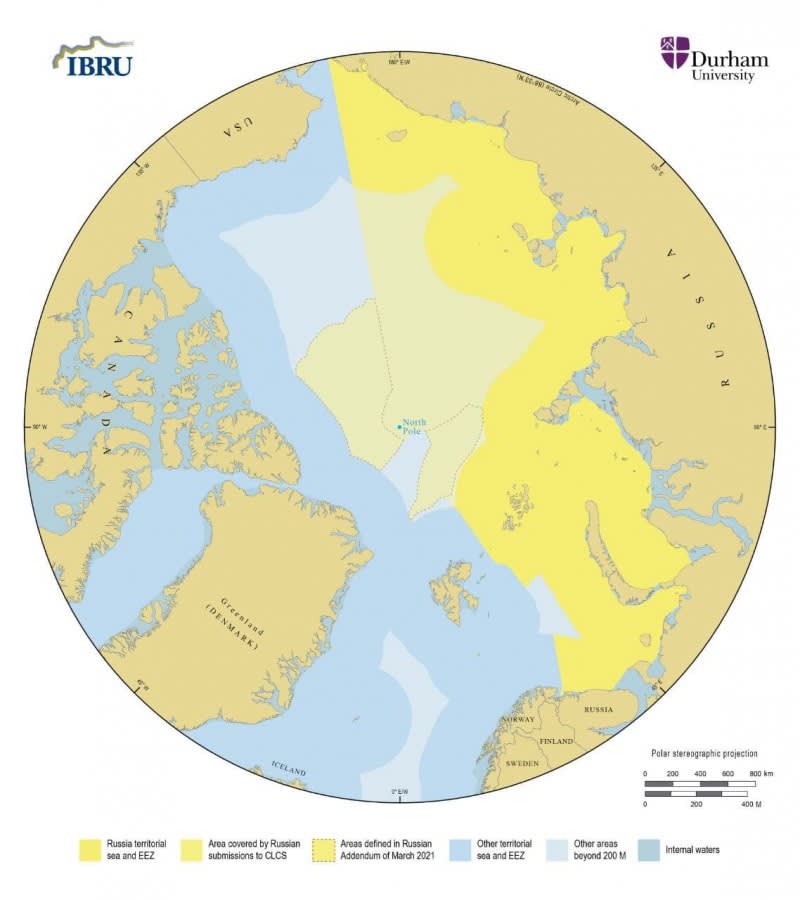Russia Considers Extended Claim to the Arctic Seabedhttps://www.highnorthnews.com/en/russia-considers-extended-claim-arctic-seabedTwo Russian vessels have collected new data in the Arctic Ocean between Canada, Greenland and the North Pole - far from Russia’s existing claim.
It happened between August and October last year. Through several days, Russia’s large nuclear icebreaker “50 Let Pobedy” (50 Years of Victory) plowed through the polar sea ice between the North Pole and the northernmost reaches of Greenland and Canada. The speed most likely is no more than 3-4 knots.
The icebreaker systematically clears open tracks in the ice in honor of the vessel trailing it, the “Akademik Fedorov”. The lesser, but ice-enforced vessel methodically sucks up data about the seabed with an advanced multibeam echosounder embedded in its hull.
... The two Russian vessels toiled forth and back across the Lomonosov Ridge as close as 60 nautical miles from Greenland’s exclusive economic zone. They operated far from the seabed further north that was covered by Russia’s submission to the CLCS in 2015.

Focus is on the Lomonosov Ridge, the impressive subsea mountain range that runs from Russia across the North Pole and onwards towards Greenland and Canada. The ridge pushes 3700 meter tall peaks upwards from the seabed which is otherwise flat as a pancake, and the nature of the connection between the ridge and the landmasses at either end will determine who has the rights to what the seabed may hide of oil, gas and minerals.
Consistent rumors about the goal of this ambitious Russian mission can now be verified: The two vessels were harvesting data about the seabed, because Russia is contemplating a revised, enlarged submission to the UN’s Commission on the Limit of the Continental Shelf (CLCS).
A such enlarged submission could win Russia the rights to the seabed from close to the North Pole and down all the way to the maritime borders of Canada and Greenland 200 nautical miles from shore.
... “It appears that they have done bathymetry, in other words mapping of the topography across the Lomonosov Ridge. Also, they have taken samples of the sediments. It is all about illustrating the character of the ridge: Does it belong to Greenland or does it belong to Russia? But we have not yet heard what came out of it,” Flemming Larsen, director of the Geological Survey of Denmark and Greenland said.
Russia has received encouraging rumblings from the CLCS on its existing submission, and new details about the latest mission corroborate expectations of an enlargement.
... In the most far reaching scenario, where Russia manages to realize the full potential of an enlarged submission to the CLCS, Russia’s rights to the seabed would begin right outside Canada’s and Greenland’s exclusive economic zones 200 nautical miles from shore.
Russia would have exclusive rights to all resources on the seabed, but, importantly, not in the water column, on the surface, or in the airspace above. Also, Russia would command certain rights to regulate traffic in the area in order to protect its riches.
These are privileges and potential wealth to which Greenland and Canada have so far been the only contenders.
According to an educated estimate an extended Russian submission could potentially increase the overlap between Russia’s existing claim and that of Denmark and Greenland with some 200.000 square kilometers, adding to an overlap already at 600.000 square kilometers.
On top of this, an enlarged Russian submission would most likely increase Russia’s overlap also with the Canadian and possibly the US designs.
